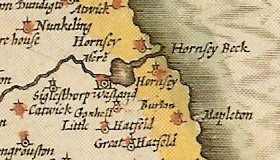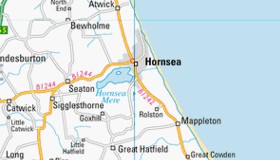My home town is Hornsea in East Yorkshire, as I've mentioned in QBlog before. Here it is on a map made in 1610 by John Speed:

That's Hornsea (Horn∫ey) there next to the Mere. It's south of the stream connecting the Mere to the sea (which is called the Stream Dike, and after straightening is nowadays south of the old centre of Hornsea). North of Hornsea on the map is another town, Hornsea Beck. A beck is what we call a fast-running brook in Yorkshire, the word originating in Viking times. Hornsea Beck got its name because it was clustered where the Stream Dike met the sea.
Here's a modern map:

As you can see, there's no Hornsea Beck. Although anywhere else the sensible assumption would be that the smaller village became absorbed by its expanding parent, that's not what happened here. Firstly, Hornsea Beck had about the same population as Hornsea, so it wasn't actually all that smaller (and may at times have been larger). Secondly, remember Hornsea Burton? Yes, that's right: Hornsea Beck was taken by the sea, as result of Holderness's notorious coastal erosion. By 1695, only one or two houses remained.
Yeah, I know, mildly interesting but you're not from Hornsea so you don't care.
OK, so I was researching all this for fun the other day, when I came across a reference in the University of York Centre for Medieval Studies. It's from a Gazetteer of the Religious Gilds and Services of Late Medieval Yorkshire. To save you looking, here's what it said:
Church in possession of St Mary's Abbey York. Nearby Hornseabeck (since eroded) in possession of Meaux Abbey. Dispute over ownership of Hornsea Mere settled by combat in 1260 in favour of St Mary's.
OK, but it's what followed that caught my eye:
Anthony St Quentin prebend of Milton, Lincoln Minster, will dated 10/07/1430 probate 11/08/1430: 10s. each to four fraternities of Corpus Christi, Holy Trinity, St Mary, St Katherine. All "founded at an early period".
What this is saying is that there were four guilds associated with the parish church, dating from some time before 1430. The names of these guilds were: Corpus Christi, Holy Trinity, St Mary and St Katherine.
I've heard those names before.
Corpus Christi, Trinity, St Mary's, St Catherine's: green, yellow, blue, red.
Those were the names of the houses in Hornsea School, where I went from age 11-18. As the school expanded, two more were added (Lotens and St Nicholas — I was in Lotens), and later another two (Acklam and Constable). I believe they were later merged back down to four, but I think they've gone now. I was always under the impression that the houses were named after Oxford Colleges, but apparently not: they were named after the town's medieval guilds.
So sure was I that I dug out a booklet I have, Hornsea School 1958-1983, and checked what it said. There, on a page headed "A HISTORY OF THE HOUSES OF HORNSEA SCHOOL", it said the houses were "named after the four Hornsea Trade Guilds which were prominent in the town in the 17th and 18th Centuries, and which were the successors of the medieaeval Church Guilds".
Augh! That's an interesting fact! I remember interesting facts! I've read that booklet before, and I should have remembered that interesting fact. It was interesting because it conflicted with what I'd been told, but instead of remembering the interesting fact I remembered the falsehood that made it interesting. Damn! That's not supposed to happen. How could I have remembered the wrong thing? I should have remembered both, like I do with du pain. Why just one?
Augh! Wail, wail, lament.